Apr-23-11
 | | AylerKupp: The game on Apr-23-11, Rybka 4.1 (AylerKupp) vs. Houdini 1.5 (Golden Executive) ended in a draw by repetition after 76 moves. The game score: 1.e4 c5 2.Nc3 Nc6 3.Nf3 e6 4.d4 cxd4 5.Nxd4 Qc7 6.Be2 a6 7.Be3 Nf6 8.O-O Bb4 9.Nxc6 bxc6 10.Qd3 a5 11.Bd4 Bd6 12.Qh3 Be5 13.Bxe5 Qxe5 14.Qe3 O-O 15.f4 Qb8 16.b3 e5 17.Rad1 Re8 18.f5 Qb4 19.Bf3 Ba6 20.Rfe1 Rad8 21.Na4 d6 22.h3 h6 23.Rd2 Bb5 24.Nc3 d5 25.Nxb5 cxb5 26.c3 Qa3 27.Red1 a4 28.bxa4 b4 29.Qc5 Qxc3 30.Rc2 Qa3 31.exd5 Qxa4 32.d6 e4 33.Be2 Re5 34.Qxe5 Qxc2 35.Qa5 Rd7 36.Kf2 e3+ 37.Kxe3 Qe4+ 38.Kf2 Qf4+ 39.Bf3 Rxd6 40.Rxd6 Ne4+ 41.Kg1 Nxd6 42.Qa8+ Kh7 43.Qd5 f6 44.Be2 h5 45.Bxh5 Nxf5 46.Bg4 Ng3 47.Bf3 Kh6 48.Kf2 f5 49.Ke1 Kg6 50.Kd1 Nh5 51.Kc2 Nf6 52.Qc5 Kh7 53.Kb3 Ne4 54.Qxb4 Qc1 55.Bxe4 Qe3+ 56.Kb2 fxe4 57.a4 Qe2+ 58.Kc3 Qe3+ 59.Kb2 Qf2+ 60.Kc3 Qg3+ 61.Kd4 Qd3+ 62.Ke5 e3 63.Qg4 Kg8 64.Qe6+ Kf8 65.Qc8+ Kf7 66.Qe6+ Kf8 67.Qc8+ Ke7 68.Qb7+ Kd8 69.a5 e2 70.Qb6+ Kc8 71.Qc6+ Kd8 72.Qb6+ Ke8 73.Qe6+ Kf8 74.Qc8+ Ke7 75.Qe6+ Kd8 76.Qb6+ draw by repetition I thought that Rybka missed 2 wins, one in the opening/middle game by failing to press its k-side attack more energetically and prevent Black's freeing ...d5 and one in the endgame when it failed to exchange queens leading to what I thought was a won B vs. N endgame. It was a good game with first Rybka having the advantage and then Houdini having the advantage. And Houdini was trying to win all the way to the end of the game. The game achieved a hotness level of 8.5 in the Rybka/Fritz GUI! And I found out after the game that I may not have had Ponder=ON and that might have made all the difference. Oh well. And the game introduced the "Flying Papers" variation of the Sicilian. More on that ... |
|
Apr-23-11
 | | AylerKupp: The "Flying Papers" variation of the Sicilian. Named after the following exchange in the chat room: <aylerkupp>: With such a sharp game (hopefully), I think I'll let R play and take my chances on the time control later. <goldenexecutive10>: Yes, It s a Sicilian <aylerkupp>: Definitely out of the books <goldenexecutive10>: B49 Sicilian: Taimanov Variation <aylerkupp>: Is all this still book? <aylerkupp>: The Sicilian has too many variations and sub-variations for mere mortals. (a little later)
<goldenexecutive10>: I just started a fan to cooling my laptop <aylerkupp>: Game too hot for it? LOL <goldenexecutive10>: Yes !! LOL <aylerkupp>: Maybe for the next game you can place it on top of a bag of ice or one of those cooling packs. Seriously (sort of) <goldenexecutive10>: I must do something, right now I have papers flying around <aylerkupp>: We'll call this the "Flying Papers" variation of the Sicilian Sorry, I couldn't resist. Particularly when the game reached 8.5 on the hotness gauge. |
|
Apr-24-11
 | | AylerKupp: Commentary on game Rybka 4.1/<AylerKupp> vs. Houdini 1.5a/<Golden Executive> on Apr-23-11. (part 1 of 6) Yesterday when I posted the game score I felt that Rybka missed 2 wins, one during the opening/middle game and one during the endgame. Well, as I should know by now, Rybka plays much better than I do. The presumed win during the opening/middle game was an illusion, Black's freeing ...d5 couldn't have been prevented (at least I couldn't figure out how to do it). And the presumed win during the endgame, while possible, was also an illusion since neither engine would have gotten to the winning position for White. So, here's the annotated game score with my comments. I included Rybka's search depth, evaluation of its main PV, and calculation time in case anyone finds it of interest. As before, I set aside 12 minutes for Clock Lag. I'm now calling it Clock Lag instead of Operator Lag since there are apparently communication delays between the Yahoo! Chess clients (the web browser) and the Yahoo! Chess server that are also factors. My average Clock Lag (it's different for each side) was 8.9 secs/move which I guess it's good enough (it allows for an 80-move game) although not as good as my 7.1 secs/move during my game with the "carbon units". I apparently had too much coffee before and during the game (the game starts at 9:00 PDT) and you can probably figure out what caused the increased average Clock Lag. I again let Rybka suggest all the moves but forced it to move if I saw it was contemplating a move that I preferred (particularly in the opening), when it had achieved a reasonable depth (17 – 19 plies early in the game, deeper later in the game), and when I felt by looking at the difference in the evaluation of the 1st and 2nd PVs that a different move was unlikely if I let it calculate one more ply (and therefore there was no point in letting Rybka calculate further). I was less aggressive in forcing it to move than in my previous game since then I had over 40 minutes left at the end of the 65-move game and this time I had 11 minutes left by the end of the 75 minute game. It's all a guessing game, of course, but at least my guessing is getting better. Upon replaying the game I found it incredibly interesting and very human-like, more so than during the game itself (and I thought it was pretty interesting then). So I've gone into the game in much more detail that I normally would have, with more diagrams than usual. I hope that you bear with it and that you find the game as interesting and human-like as I did. White Black Depth Eval Time
1.e4 c5 13 +0.12 4
2.Nc3 Nc6 14 +0.25 10
3.Nf3 e6 11 +0.25 1
4.d4 cxd4 10 +0.30 1
5.Nxd4 Qc7 9 +0.30 1
6.Be2 a6 12 +0.46 12
7.Be3 Nf6 13 +0.45 11
8.O-O Bb4 15 +0.30 44
9.Nxc6 bxc6 16 +0.28 57
10.Qd3 a5 16 +0.17 110
11.Bd4 Bd6 16 +0.32 67
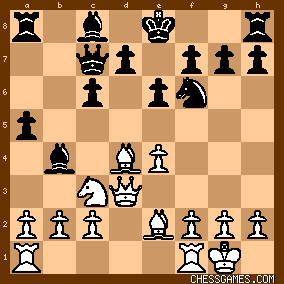
click for larger view
(11.Bd4) And here we are out of the book. It's interesting that Rybka managed to come up with 10 book moves. But I didn't like Houdini's reaction which, though not uncommon in this variation, relieves pressure on White's e-pawn and blocks Black's d-pawn, at least temporarily. So I think that Rybka is the winner of the first non-book move, but I wasn't entirely happy about its choice for defending White's h-pawn since it put its queen opposite Black's LSB after the inevitable advances of both the d-pawn and e-pawn. |
|
Apr-24-11
 | | AylerKupp: Commentary on game Rybka 4.1/<AylerKupp> vs. Houdini 1.5a/<Golden Executive> on Apr-23-11. (part 2 of 6) White Black Depth Eval Time
12.Qh3 Be5 18 +0.31 214
13.Bxe5 Qxe5 16 +0.30 51
14.Qe3 O-O 18 +0.25 168

click for larger view
(14...0-0) "Phew!" was <Golden Executive>'s reaction to Black finally being able to castle. But I think that Black could have postponed 0-0 one move longer and tried 14...d5 with full equality. Now Black should not have been given a second chance to play ...d5. (and almost wasn't). White Black Depth Eval Time
15.f4 Qb8 17 +0.23 105
16.b3 e5 17 +0.22 106

click for larger view
(16...e5) 16...d5 was still possible. If then 17.e5 Nd7 18.Na4 c5 and Black should be OK. White Black Depth Eval Time
17.Rad1 Re8 16 +0.26 94
18.f5 Qb4 16 +0.19 68

click for larger view
(18.f5) Now, if White can prevent ...d5, he should be able to work up a k-side pawn storm with h4, g4-5, etc. Black may be able to survive if he can exchange queens. But, as the analysis and the game shows, White apparently can't prevent ...d5, although Rybka sure tried. White Black Depth Eval Time
19.Bf3 Ba6 17 +0.18 226
20.Rfe1 Rad8 18 +0.13 105

click for larger view
(20.Rfe1) Here I thought that 20.Rf2 would be better with the idea of Rfd2. But 20...d5 is then possible, 20...d5 21.exd5 e5 22.Be2 cxd5. Rybka evaluates this position at [-0-11], d=18. So maybe in retrospect 19.Rd2 with the plan of doubling rooks on the d-file and attempt to prevent ...d5 that way might have been better (Rd6 would then have been awfully strong). 19.Rd2 instead of 19.Bf3 would have also prevented ...Ba6, or at least eliminated Black's well-placed bishop and prevented later tactical tricks on e4. White Black Depth Eval Time
21.Na4 d6 18 +0.16 123
22.h3 h6 17 +0.05 92
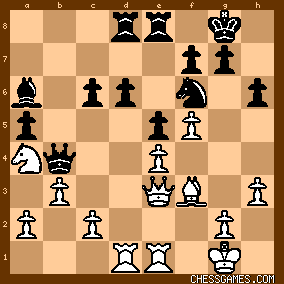
click for larger view
(22.h3) I thought at the time that this was too slow. 22.c4 is not possible because of 22...Bxc4, a consequence of 19.Bf3. I thought of 22.g4 h6 23.h4 but 23...d5 is still possible and gives Black a slight edge. It's proving to be more difficult to prevent ...d5 than I thought during the game because of the ...e4 push after exd5. And Black's ...h6 will come in very handy later in the game. White Black Depth Eval Time
23.Rd2 Bb5 18 +0.03 246
24.Nc3 d5 16 +0.03 111

click for larger view
(24...d5) Finally! Here Rybka's evals took a tumble, from [+0.03] to [-0.26]. White Black Depth Eval Time
25.Nxb5 cxb5 17 -0.26 189
26.c3 Qa3 15 -0.20 39
27.Red1 a4 16 -0.20 36
28.bxa4 b4 16 -0.26 85

click for larger view
(28...b4) I thought that the last 2 moves were excellent moves on Houdini's part and almost human. First counter in the center to blunt White's k-side attack and then counter on the q-side to weaken White's pawns. And possibly also gaining a passed d-pawn in the process. |
|
Apr-24-11
 | | AylerKupp: Commentary on game Rybka 4.1/<AylerKupp> vs. Houdini 1.5a/<Golden Executive> on Apr-23-11. (part 3 of 6) White Black Depth Eval Time
29.Qc5 Qxc3 16 -0.30 141
30.Rc2 Qa3 16 -0.30 69

click for larger view
(30.Rb2) But this luckily saves the day. Although luck had nothing to do with it, just calculation. White Black Depth Eval Time
31.exd5 Qxa4 15 -0.30 58
32.d6 e4 16 -0.30 86
33.Be2 Re5 15 -0.30 21
34.Qxe5 Qxc2 17 -0.19 203
35.Qa5 Rd7 16 -0.19 87

click for larger view
(35.Qa5) Attack, defense, and counterattack, all in one move! I wish I could play like that. White Black Depth Eval Time
36.Kf2 e3+ 17 -0.18 119

click for larger view
(36...e3+) An interesting temporary pawn sac and one that wasn't obvious to me. Might have been successful OTB, particularly if White was short of time. White Black Depth Eval Time
37.Kxe3 Qe4+ 14 -0.18 65
38.Kf2 Qf4+ 15 -0.18 26
39.Bf3 Rxd6 14 -0.18 20

click for larger view
(39...Rxd6) Eliminating White's dangerous passed pawn. I remarked during the game that it's too bad that Black's h-pawn wasn't still on h7 because then 40.Qd8+! wins prettily. But, of course, Houdini would have seen that, probably back at 33...Re5. White Black Depth Eval Time
40.Rxd6 Ne4+ 19 -0.15 88
41.Kg1 Nxd6 18 -0.15 57
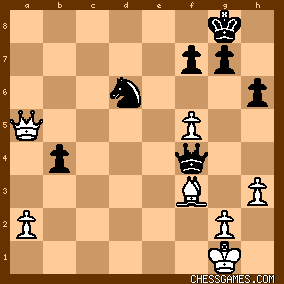
click for larger view
(41...Nxd6) Now it looks like the Pf5 is a goner but Rybka finds an active defense. White Black Depth Eval Time
42.Qa8+ Kh7 20 -0.16 50
43.Qd5 f6 18 -0.16 18
44.Be2 h5 20 -0.16 57
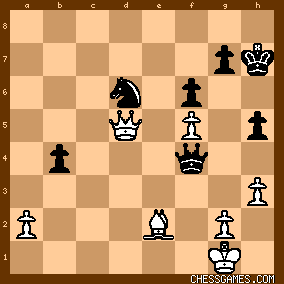
click for larger view
(44.Be2) And now, of course, the Pf5 is immune due to the pin after Bd3 and the possibility of g4. White Black Depth Eval Time
45.Bxh5 Nxf5 20 -0.16 53

click for larger view
(45.Bxh5) Here and a little bit later I thought that the queen exchange would be a win for White. But here the queen exchange is premature. If instead 45.Qf3 Qxf5 46.Qxf5 Nxf5 47.Bxh5 then after 47...Kh6 48.Bg4 Kg5 Black's king is sufficiently far advanced (and White's king sufficiently far behind) to make the position even. |
|
Apr-24-11
 | | AylerKupp: Commentary on game Rybka 4.1/<AylerKupp> vs. Houdini 1.5a/<Golden Executive> on Apr-23-11. (part 4 of 6) White Black Depth Eval Time
46.Bg4 Ng3 19 -0.21 45
47.Bf3 Kh6 20 -0.14 53
48.Kf2 f5 20 -0.14 42
49.Ke1 Kg6 21 0.00 119

click for larger view
(49.Ke1) The last critical point in the game and the one which I looked at in the greatest detail. Here I thought that 49.Qe6+ Kg5 50.Qe3 Qxf3+ 51.Ke3 would win for White since the White king can go over and capture Black's b-pawn while the bishop guards the k-side pawns. Black's short-range knight can't be on both sides of the board at once. And Rybka agrees, looking at either: [+3.09], d=26: 51. ... Kh4 52.Kd4 Ne4 53.Bxe4 fxe4 54.Kxe4 Kg3 55.Kf5 Kxg2 56.h4 Kg3 57.h5 Kh3 58.Kg5 Kg3 59.Kg6 Kg4 60.Kxg7 Kxh5 61.Kf6 Kg4 62.Ke5 Kg3 63.Kd4 Kf4 64.Kc5 Ke5 65.Kxb4 Kd6 66.a4 Kc7 [+4.45], d=26: 51. ... Kf6 52.Kd4 Ke7 53.Kc5 Kd8 54.Kxb4 Kc7 55.Kc5 f4 56.Kd5 Nf5 57.Ke4 Ne7 58.Kxf4 Ng6+ 59.Kf5 Nf8 60.h4 Kd6 61.g3 Kc7 62.Ke5 Kd7 63.a4 Ng6+ 64.Kd4 Ne7 65.a5 Kd6 66.a6 Nc8 But, equally or more important, what would Houdini have done? Well, here are two possibilities (analysis by Houdini 1.5a): [+0.41], d=30: 51. ... Kh4 52.Bc6 g5 53.Kd3 Ne4 54.Kc4 Kg3 55.Kxb4 Kxg2 56.a4 Kxh3 57.Bd7 g4 58.Bxf5 Nd6 59.Be6 Kh4 60.Bd5 Nc8 61.a5 g3 62.Bg2 Kg4 63.Kc5 Kf4 64.Kd4 Na7 65.a6 Nc8 66.Bh1 Na7 67.Kd5 Nb5 68.Kc5 Na7 69.Kb6 Nc8+ 70.Kb7 Nd6+ 71.Kb6 Nc8+ 72.Kb7 [+2.98], d=30: 51. ... Kf6 52.Kd4 Ke6 53.Kc5 g5 54.Kxb4 Kd6 55.Kc4 Nf1 56.Kd4 Nd2 57.a4 Nb3+ 58.Kc3 Nc5 59.a5 Kc7 60.Kc4 Kd6 61.Kb5 Ne6 62.a6 Nc7+ 63.Kb6 Nxa6 64.Kxa6 Kc5 65.Ka7 Kc4 66.Kb6 Kd4 67.Bc6 g4 68.hxg4 fxg4 69.Kb7 Kc3 70.Kc7 Kd4 71.Kd6 g3 72.Bf3 Ke3 73.Ke5 So Houdini didn't evaluate the 51...Kh4 line nearly as bad for Black as Rybka did. But Houdini's 52.Bc6 in that line doesn't make much sense, Rybka's going after Black's b-pawn immediately seems much better. So, in my opinion, based on this game and other games and analyses, I think that Rybka is a better engine in the endgame than Houdini. And I'm sure those are fighting words! But is the queen exchange after 49.Qe6+ likely? Well, Houdini probably would have played 49...Kh7 ([-0.07] vs. [0.00] for 49...g6 at d=28 (analysis by Houdini 1.5a), and evaluated 49...Kh7 and 49...g6 in that order of preference that since d=8). And Rybka's response to 49...Kh7 would have been either 50.Qd7 ([-0.10], d=22) or 50.Qb6 [(-0.11], d=22) (analysis by Rybka 4.1). So the answer is that Rybka may have had a won endgame after the queen exchange, but couldn't get to it. White Black Depth Eval Time
50.Kd1 Nh5 21 0.00 130
51.Kc2 Nf6 19 0.00 78
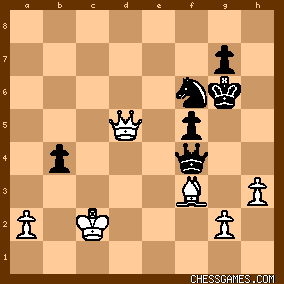
click for larger view
(51.Kc2) At least Rybka knows to go after Black's b-pawn as the only possible winning chance, but it looks like it nearly loses the game doing so, even though Rybka must have calculated that it wouldn't. |
|
Apr-24-11
 | | AylerKupp: Commentary on game Rybka 4.1/<AylerKupp> vs. Houdini 1.5a/<Golden Executive> on Apr-23-11. (part 5 of 6) White Black Depth Eval Time
52.Qc5 Kh7 20 0.00 60
53.Kb3 Ne4 20 +0.15 85
54.Qxb4 Qc1 21 0.00 38
55.Bxe4 Qe3+ 20 0.00 59
56.Kb2 fxe4 20 0.00 40
57.a4 Qe2+ 20 0.00 30

click for larger view
(57.a4) After an interesting exchanging sequence Rybka winds up a pawn ahead. But now it's a race, and Black is ahead. White Black Depth Eval Time
58.Kc3 Qe3+ 19 0.00 50
59.Kb2 Qf2+ 23 0.00 49

click for larger view
(59.Kb2) Here I thought that Houdini would go for the draw by repetition that Rybka was apparently offering. But no, Houdini decides to become aggressive even though (or maybe because) it's a pawn down. White Black Depth Eval Time
60.Kc3 Qg3+ 21 0.00 28
61.Kd4 Qd3+ 22 0.00 75
62.Ke5 e3 16 0.00 24

click for larger view
(62...e3) The point of no return. Now Black's e-pawn is not catchable so Rybka has a draw, at best. But Rybka had obviously calculated all this. White Black Depth Eval Time
63.Qg4 Kg8 22 0.00 46
64.Qe6+ Kf8 24 0.00 38
65.Qc8+ Kf7 22 0.00 36
66.Qe6+ Kf8 22 0.00 28
67.Qc8+ Ke7 23 0.00 32
68.Qb7+ Kd8 21 0.00 36
69.a5 e2 20 0.00 29

click for larger view
(69.a5) In a human that would be called "nerves of steel", "ice in its veins", or some other expression that indicated confidence that the draw was still obtainable in spite of Black's Pe2. But, with one exception on move 53, Rybka's evals had been at [0.00] since move 49 and that seldom happens at this stage of a game unless the draw is apparent, so it may have seen this far! If that's the case, it's truly amazing. |
|
Apr-24-11
 | | AylerKupp: Commentary on game Rybka 4.1/<AylerKupp> vs. Houdini 1.5a/<Golden Executive> on Apr-23-11. (part 6 of 6) White Black Depth Eval Time
70.Qb6+ Kc8 15 0.00 13
71.Qc6+ Kd8 14 0.00 10
72.Qb6+ Ke8 17 0.00 39
73.Qe6+ Kf8 17 0.00 22
74.Qc8+ Ke7 19 0.00 13
75.Qe6+ Kd8 17 0.00 26
76.Qb6+ draw 15 0.00 13

click for larger view
(76.Qb6) Draw by repetition. A proper finish after excellent play by both engines. I hope you enjoyed the game as much as I did, both during and afterwards. <Golden Executive> It looked like Houdini tried very hard to avoid the draw so I'm curious how early its evaluations became [0.00], if they ever did (I've found Houdini to be more optimistic than Rybka). For engines to give up a pawn without obvious material compensation is rare, unless they evaluate the position as advantageous in spite of the material deficit. Houdini has a UCI parameter checkbox called "Analysis Contempt" (unchecked by default) and a parameter called "Contempt" which defaults to 1. But if the "Analysis_Contempt" box is checked and the "Contempt" value is set to 2 then Houdini tries to avoid a draw if at all possible (and if "Contempt" is set = 0 then it accepts draws more easily than usual). Could you check to see if the "Analysis Contempt" box was checked and what value you used for the "Contempt" parameter for this game? Given the way the games against the Masters are going (2 draws so far) you might want to check the "Analysis Contempt" box and set "Contempt" = 2 in your game with them. It might make your game even more interesting although, of course, you would be taking an additional risk. |
|
| Apr-26-11 | | Golden Executive: First, some information, statistics and game plan (strategies): [Event "CG.com Masters vs Machines Invitational (2011)"] [Site ""Yahoo! chess"]
[Date "2011.04.23"]
[Round "2"]
[White "Rybka 4.1/<AylerKupp>"] [Black "Houdini 1.5a w32/<Golden Executive>"] [Result "1/2-1/2"]
[ECO "B49"]
[PlyCount "152"]
[TimeControl "105 minutes/no increments"]
The opening was Sicilian, Taimanov Variation (B49) This is a notable game about this kind of opening: Tal vs Taimanov, 1962 As a reminder, my basic strategy for the game vs Stockfish was: "I started the game using the fixed time approach: 105 less 10 minutes for operator lag time, for a 70 moves game.
For the first 8 moves I used the Opening Explorer in combination with the suggested move by Houdini (in this approach I just can not select by myself directly a move from the OE, that is only possible in the Infinite Analysis approach). After the 8 move, the engine was on its own and I just forced to move (pressing my spacebar) if I felt the engine reached a reasonable depth or the move was so obvious" For this game I did some important changes:
In order to have more freedom about the opening, I switched from Fixed Time approach to Infinite Analysis Mode PV=2 for the first eight moves and I wrote some game plan for the most probably opening move for Rybka being white. Rybka played 1.e4 and in my game plan I decided to go for the Sicilian in that case. I also previously decided to play one of the main moves of the Opening Explorer by my own ! So for the first 8 moves, I budgeted I would be the one deciding the moves !! (Last time I was forced to select one of the Houdini´s suggestions vs Stockfish). That was a big deal for me.
In my game plan I considered this: "If you are not sure what to do, then play the very first move of OE¨" I did it
After move 8, I switched to Fixed Time approach and some moves later, with the help of my fan, the "Flying Papers" variation of the Sicilian appeared. I think is the properly name because one of those papers were my game plan / chart control time management and other notes.... My next post will be focusing to the analysis of the game moves. <AylerKupp> Your analysis of the game is such impressive. I will try to do my best in order to add some value.
p.s. I really suffered/enjoyed the game. The balance said: Enjoy wins p.s.1. Being a spacebar master is not an easy cake... |
|
| Apr-26-11 | | Golden Executive: Analysis of the Game (part 1)
I am adding after the slash, the results from Houdini (when is empty it´s because I picked-up the move "manually"). White Black Depth Eval Time
1.e4 c5 13 +0.12 4
2.Nc3 Nc6 14 +0.25 10/ 14 +0.16 14
3.Nf3 e6 11 +0.25 1/ 13 +0.17 12
4.d4 cxd4 10 +0.30 1/ 10 +0.18 12
5.Nxd4 Qc7 9 +0.30 1
6.Be2 a6 12 +0.46 12
7.Be3 Nf6 13 +0.45 11/ 12 +0.46 16
8.O-O Bb4 15 +0.30 44/ 18 +0.13 17
9.Nxc6 bxc6 16 +0.28 57/ 13 +0.13 16
10.Qd3 a5 16 +0.17 110/ 18 +0.04 143
10.Qd3 was the last move you can find in the Opening Explorer. 11.Bd4 Bd6 16 +0.32 67/ 21 +0.04 88

click for larger view<I wasn't entirely happy about its choice for defending White's h-pawn since it put its queen opposite Black's LSB after the inevitable advances of both the d-pawn and e-pawn.> I agree but the other main choice seems to be drawish. Analysis by Houdini 1.5 depth 25
1. = (0.09): 12.Qh3 h5 13.Rad1 Rb8 14.b3 Bf4 15.Be3 d5 16.Bxf4 Qxf4 17.Qf3 Qe5 18.exd5 exd5 19.Rfe1 0-0 20.Bd3 <2. = (0.04): 12.Bxf6 gxf6 13.Kh1 Be5> 14.Rad1 h5 15.h3 h4 16.Na4 Rg8 17.c3 Rb8 18.b3 Kf8 19.Qe3 Bf4 20.Qc5+ Kg7 21.Qh5 Bg5 22.Nc5 d5 Look the position after 12.Bxf6 gxf6 13.Kh1 Be5:
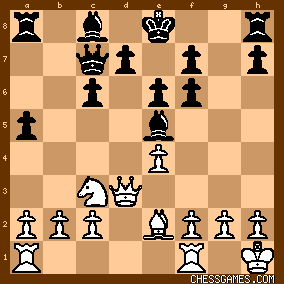
click for larger viewAnalysis by Houdini 1.5 depth 20
1. = (0.00): 14.Rad1 h5 15.h3 Rb8 16.b3 Rb4 17.Na4 d5 18.Nc5 Rb5 19.Na4 Rb4 20.Nc5 2. = (0.00): 14.Na4 h5 15.Qe3 Bf4 16.Qd4 Be5 17.Qe3 Bf4 3. = (0.00): 14.Qe3 Bf4 15.Qd4 Rb8 16.Rab1 Qe5 17.Qd3 Qd6 18.Qf3 Be5 19.Qe3 Bf4 20.Qf3 Be5 4. = (0.00): 14.Qd2 Bf4 15.Qd4 Rb8 16.Rab1 Qe5 17.Qd3 Qd6 18.Qf3 Be5 19.Qe3 Bf4 20.Qf3 Be5 5. = (-0.01): 14.Rab1 h5 15.h4 a4 16.a3 Ke7 17.Qf3 Bd4 18.Rbd1 Qb6 19.Qg3 Bb7 20.Qf3 Be5 21.Qd3 Rhd8 22.f4 Ba6 23.Qf3 Bxe2 24.Qxe2 |
|
Apr-26-11
 | | AylerKupp: <<Golden Executive> p.s.1. Being a spacebar master is not an easy cake...> I agree, and being a GOOD spacebar master is even harder. Little did PZ know that he was giving us a compliment! And thanks for your annotations. I'm glad that you also "really suffered/enjoyed the game". Now you and Houdini go get those pesky humans on Friday! |
|
| Apr-26-11 | | Golden Executive: Analysis of the Game (part 2)
I am adding after the slash, the results from Houdini White Black Depth Eval Time
12.Qh3 Be5 18 +0.31 214/ 20 +0.11 78
13.Bxe5 Qxe5 16 +0.30 51/ 23 +0.09 0
14.Qe3 O-O 18 +0.25 168/ 24 +0.07 0
Rybka used more than 7 minutes, Houdini used less than 2. The position was not critical, so it´s highly probable the effect of the Ponder=Off in Arena´s GUI.In the other hand, Houdini played 14..0-0 reaching depth 24 using 0 seconds (the "permanent brain" function Fritz interface´s effect I guess). <(14...0-0) "Phew!" was <Golden Executive>'s reaction to Black finally being able to castle. But I think that Black could have postponed 0-0 one move longer and tried 14...d5 with full equality. Now Black should not have been given a second chance to play ...d5. (and almost wasn't).> This was the chat:
"<goldenexecutive10>: Phew! finally <aylerkupp>: R is not going to make ...d5 easy <aylerkupp>: You may need to take back that "Phew!" After reviewing <14..d5> 
click for larger viewAnalysis by Houdini 1.5 w32 <depth 24>: <1.  (0.43) 15.Qc5> Bd7 16.f3 Qb8 17.exd5 Qb4 18.Qxb4 axb4 19.dxc6 bxc3 20.cxd7+ Kxd7 21.Rfb1 Rhb8 22.b3 Ra3 23.Rd1+ Kc6 24.Rd3 Nd5 25.f4 Rba8 26.Bf3 Rxa2 27.Bxd5+ exd5 28.Rxc3+ Kd6 29.Rd1 Ra1 30.Rxa1 Rxa1+ 31.Kf2 Rh1 32.Rg3 Rc1 33.Rxg7 Rxc2+ 34.Ke3 (0.43) 15.Qc5> Bd7 16.f3 Qb8 17.exd5 Qb4 18.Qxb4 axb4 19.dxc6 bxc3 20.cxd7+ Kxd7 21.Rfb1 Rhb8 22.b3 Ra3 23.Rd1+ Kc6 24.Rd3 Nd5 25.f4 Rba8 26.Bf3 Rxa2 27.Bxd5+ exd5 28.Rxc3+ Kd6 29.Rd1 Ra1 30.Rxa1 Rxa1+ 31.Kf2 Rh1 32.Rg3 Rc1 33.Rxg7 Rxc2+ 34.Ke3 Phew ! seems like my phew ! OTB (or OTVB: Over the Virtual Board) was o.k. |
|
| Apr-26-11 | | Golden Executive: Analysis of the Game (part 3)
White Black Depth Eval Time
15.f4 Qb8 17 +0.23 105/ 22 +0.12 146
16.b3 e5 17 +0.22 106/ 22 +0.04 0
<(16...e5) 16...d5 was still possible. If then 17.e5 Nd7 18.Na4 c5 and Black should be OK.> Yes, it is.
17.Rad1 Re8 16 +0.26 94/ 21 0.00 81
18.f5 Qb4 16 +0.19 68/ 21 +0.11 <307> After 18.f5:
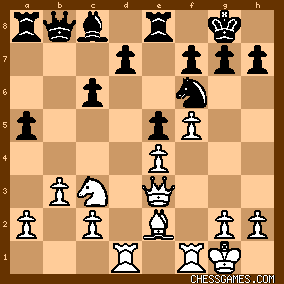
click for larger view the chat was:
" <goldenexecutive10>: closing the center I meant <aylerkupp>: If R follows that with g4 and H can't get his q-side attack going then I think it's going to have problems. <goldenexecutive10>: Yes. I think you are right <aylerkupp>: I hope that R realizes that it must prevent ...d5 at all costs. <aylerkupp>: I think it does since it's looking at both Bf3 and Rd2" So I decided to let Houdini take it´s time.
After the review, although 18..Qb4 was always the PV 1, 18..Ba6 was very close. My conclusion is that 18..Qb4 307 seconds was worth it because equalized the game. |
|
| Apr-28-11 | | Golden Executive: Analysis of the Game (part 4)
White Black Depth Eval Time
19.Bf3 Ba6 17 +0.18 226/ 22 -0.02 104
20.Rfe1 Rad8 18 +0.13 105/ 23 0.00 142
21.Na4 d6 18 +0.16 123/ 21 0.00 9
22.h3 h6 17 +0.05 92/ 22 +0.10 191
23.Rd2 Bb5 18 <+0.03 246/ 16 -0.07 67> 24.Nc3 d5 16 <+0.03 111/ 16 -0.28 97> 
click for larger view<(24...d5) Finally! Here Rybka's evals took a tumble, from [+0.03] to [-0.26].> This was the chat after 24..d5:
"<goldenexecutive10>: thats my boy lol <aylerkupp>: R now realizes it's in trouble., [-0.29] <aylerkupp>: Now [-0.49], d=16 <goldenexecutive10>: H (-0.40)" At the post-mortem, H evaluated the position as -0.25 at depth 26. Black was far away of a win. White Black Depth Eval Time
25.Nxb5 cxb5 17 -0.26 189/ 21 -0.36 67
26.c3 Qa3 15 -0.20 39/ 21 -0.34 105
27.Red1 a4 16 -0.20 36/ 20 -0.30 13
28.bxa4 b4 16 -0.26 85/ 20 -0.22 3

click for larger view<(28...b4) I thought that the last 2 moves were excellent moves on Houdini's part and almost human. First counter in the center to blunt White's k-side attack and then counter on the q-side to weaken White's pawns. And possibly also gaining a passed d-pawn in the process.> The chat was:
"<goldenexecutive10>: two white passed pawns! <aylerkupp>: But I wouldn't call them "strong" <goldenexecutive10>: The "hot-ness" gauge shows 8 <aylerkupp>: That must be a record so far. <goldenexecutive10>: I think so <goldenexecutive10>: I will let H uses all the time it needs <goldenexecutive10>: ha,ha,ha,ha <goldenexecutive10>: damn engines !" At the post-mortem I was trying to find a better move than <28..b4>, the best candidate move was <28..Rc8> but failed (at least at depth 24 and sliding forward). So <AylerKupp>´s evaluation of the position was so fine. |
|
| Apr-28-11 | | Golden Executive: Analysis of the Game (part 5)
White Black Depth Eval Time
29.Qc5 Qxc3 16 -0.30 141/ 21 -0.24 72
30.Rc2 Qa3 16 -0.30 69/ 21 -0.19 153
<(30.Rb2) But this luckily saves the day. Although luck had nothing to do with it, just calculation.> You mean <30.Rc2>, because <30.Rb2> gives the Queen. At Yahoo that could be a "mouse slip"... :) White Black Depth Eval Time
31.exd5 Qxa4 15 -0.30 58/ 21 -0.19 0
32.d6 e4 16 -0.30 86/ 22 -0.19 0
33.Be2 Re5 15 -0.30 21/ 19 -0.17 26
34.Qxe5 Qxc2 17 -0.19 203/ 22 -0.14 20
35.Qa5 Rd7 16 -0.19 87/ 21 -0.13 0
36.Kf2 e3+ 17 -0.18 119/ 20 -0.13 6
37.Kxe3 Qe4+ 14 -0.18 65/ 21 -0.13 182
38.Kf2 Qf4+ 15 -0.18 26/ 22 -0.12 43
39.Bf3 Rxd6 14 -0.18 20/ 23 -0.12 186
40.Rxd6 Ne4+ 19 -0.15 88/ 25 -0.13 33
41.Kg1 Nxd6 18 -0.15 57/ 25 -0.13 42
42.Qa8+ Kh7 20 -0.16 50/ <28 -0.12 0> the power of the "permanent brain" function. 43.Qd5 f6 18 -0.16 18/ 25 -0.13 35
44.Be2 h5 20 -0.16 57/ 25 -0.13 39
45.Bxh5 Nxf5 20 -0.16 53/ 25 -0.13 0

click for larger view<(45.Bxh5) Here and a little bit later I thought that the queen exchange would be a win for White. But here the queen exchange is premature. If instead 45.Qf3 Qxf5 46.Qxf5 Nxf5 47.Bxh5 then after 47...Kh6 48.Bg4 Kg5 Black's king is sufficiently far advanced (and White's king sufficiently far behind) to make the position even.> At this point, my thinking was that if H could exchange its knight for R bishop, and avoiding Queen's exchange, the game would be a draw and maybe a win for H because at that moment, H had a significative advantage in time. |
|
| Apr-28-11 | | Golden Executive: Analysis of the Game (part 6)
White Black Depth Eval Time
46.Bg4 Ng3 19 -0.21 45/ 24 -0.13 87
47.Bf3 Kh6 20 -0.14 53/ 24 -0.13 37
48.Kf2 f5 20 -0.14 42/ 24 -0.13 81
49.Ke1 Kg6 21 0.00 119/ 20 +0.03 81
<(49.Ke1) The last critical point in the game and the one which I looked at in the greatest detail. Here I thought that <49.Qe6+ Kg5> 50.Qe3 Qxf3+ 51.Ke3 would win for White since the White king can go over and capture Black's b-pawn while the bishop guards the k-side pawns. Black's short-range knight can't be on both sides of the board at once. And Rybka agrees, looking at either:[+3.09], d=26: 51. ... Kh4 52.Kd4 Ne4 53.Bxe4 fxe4 54.Kxe4 Kg3 55.Kf5 Kxg2 56.h4 Kg3 57.h5 Kh3 58.Kg5 Kg3 59.Kg6 Kg4 60.Kxg7 Kxh5 61.Kf6 Kg4 62.Ke5 Kg3 63.Kd4 Kf4 64.Kc5 Ke5 65.Kxb4 Kd6 66.a4 Kc7 Houdini probably would have played 49...Kh7 ([-0.07] vs. [0.00] for 49...g6 at d=28 (analysis by Houdini 1.5a), and evaluated <49...Kh7> and 49...g6 in that order of preference that since d=8). And Rybka's response to 49...Kh7 would have been either 50.Qd7 ([-0.10], d=22) or 50.Qb6 [(-0.11], d=22) (analysis by Rybka 4.1).> I ran Houdini PV=1 and at depth 30 has < 49..Kh7 > -0.06 <So Houdini didn't evaluate the 51...Kh4 line nearly as bad for Black as Rybka did. But Houdini's 52.Bc6 in that line doesn't make much sense, Rybka's going after Black's b-pawn immediately seems much better. So, in my opinion, based on this game and other games and analyses, I think that Rybka is a better engine in the endgame than Houdini. And I'm sure those are fighting words!> I have no elements to agree or disagree.
<So the answer is that Rybka may have had a won endgame after the queen exchange, but couldn't get to it.> I totally agree.
White Black Depth Eval Time
50.Kd1 Nh5 21 0.00 130/ 24 +0.03 0
51.Kc2 Nf6 19 0.00 78/ 22 +0.08 99 |
|
| Apr-28-11 | | Golden Executive: Analysis of the Game (part 7)
White Black Depth Eval Time
52.Qc5 Kh7 20 0.00 60/ 24 +0.09 0
53.Kb3 Ne4 20 +0.15 85/ 25 +0.09 0
54.Qxb4 Qc1 21 0.00 38/ 24 +0.08 46
55.Bxe4 Qe3+ 20 0.00 59/ 24 +0.08 0
56.Kb2 fxe4 20 0.00 40/ 24 +0.03 <311> 57.a4 Qe2+ 20 0.00 30/ 23 +0.02 40
<(57.a4) After an interesting exchanging sequence Rybka winds up a pawn ahead. But now it's a race, and Black is ahead.> After <57..Qe2+>

click for larger viewAnalysis by Houdini 1.5a <depth 25> 1. = (0.00): 58.Kc3 Qd3+ 59.Kb2 Qe2+
2. = (0.00): 58.Kc1 Qf1+ 59.Kc2 Qxg2+ 60.Qd2 Qxh3 61.a5 g5 62.Qd5 Qf3 63.Qd4 Qf5 64.Kd1 Qxa5 65.Qxe4+ Kg7 66.Qe7+ Kg6 67.Qe6+ Kg7 68.Qe7+ Kg6 3. = (0.00): 58.Kb1 Qf1+ 59.Kc2 Qxg2+ 60.Qd2 Qxh3 61.a5 g5 62.Qd5 Qf3 63.Qd4 Qf5 64.Kd1 Qxa5 65.Qxe4+ Kg7 66.Qe7+ Kg6 67.Qe6+ Kg7 68.Qe7+ Kg6 4. = (0.00): 58.Kb3 Qxg2 59.Qc3 Qf3 60.a5 e3 61.Qe5 Qd1+ 62.Kb4 Qd2+ 63.Kb3 Qd3+ 64.Kb4 Kh6 65.Qf4+ Kg6 66.Qg3+ Kf6 67.Qf4+ Ke6 68.Qg4+ Kf7 69.Qf4+ Ke6 70.Qg4+ 5. = (-0.03): 58.Ka1 Qf1+ 59.Kb2 Qxg2+ 60.Kc1 Qg1+ 61.Kc2 Qf2+ 62.Kb3 Qf3+ 63.Kc2 Qd3+ 64.Kb2 e3 65.Qc3 Qa6 66.Qxe3 Qxa4 67.Kc3 Qc6+ 68.Kd2 Kh8 69.Qd3 Qe6 70.Kc2 Qa2+ 71.Kc3 Qa5+ 72.Kb2 Qb4+ 73.Kc2 Qc5+ 74.Kb3 Qb6+ 75.Kc2 Qc7+ 76.Qc3 Qf7 6. = (-0.04): 58.Ka3 Qxg2 59.Qc3 Qf3 60.Kb2 e3 61.Qd3+ g6 62.Qd7+ Kh6 63.Qd4 Qf2+ 64.Kc3 Kh7 65.Qd7+ Kg8 66.Qd5+ Kg7 67.Qd4+ Kf7 68.Qd5+ Kf6 69.Qd4+ Ke6 70.Qe4+ Kd7 71.Qd5+ Ke7 72.Qg5+ Kf8 73.Qd8+ Kg7 74.Qd4+ Kf7 White Black Depth Eval Time
58.Kc3 Qe3+ 19 0.00 50/ 24 +0.02 7
59.Kb2 Qf2+ 23 0.00 49/ 24 +0.02 25
<(59.Kb2) Here I thought that Houdini would go for the draw by repetition that Rybka was apparently offering. But no, Houdini decides to become aggressive even though (or maybe because) it's a pawn down.> I thought the same ! but damn Houdini "forced" me to play almost 20 more moves. I requested a draw before, so I thought I must not request another (etiquette). White Black Depth Eval Time
60.Kc3 Qg3+ 21 0.00 28/ 25 +0.02 31
61.Kd4 Qd3+ 22 0.00 75/ 26 +0.02 9
62.Ke5 e3 16 0.00 24/ 26 +0.02 29
63.Qg4 Kg8 22 0.00 46/ 26 +0.02 108
64.Qe6+ Kf8 24 0.00 38/ 27 +0.02 27
65.Qc8+ Kf7 22 0.00 36/ 27 +0.07 21
66.Qe6+ Kf8 22 0.00 28/ <99> <what?> +0.07 0 <I do not understand this> 67.Qc8+ Ke7 23 0.00 32/ 28 +0.02 17
68.Qb7+ Kd8 21 0.00 36/ 24 +0.02 17
69.a5 e2 20 0.00 29/ 27 +0.07 21 |
|
| Apr-28-11 | | Golden Executive: Analysis of the Game (part 8/8)
White Black Depth Eval Time
70.Qb6+ Kc8 15 0.00 13/ 29 +0.02 7
71.Qc6+ Kd8 14 0.00 10/ 30 +0.02 8
72.Qb6+ Ke8 17 0.00 39/ <31> +0.02 3 73.Qe6+ Kf8 17 0.00 22/ 31 +0.02 4
74.Qc8+ Ke7 19 0.00 13/ 31 +0.02 4
75.Qe6+ Kd8 17 0.00 26/ <32> +0.02 4 76.Qb6+ draw 15 0.00 13.
Final Position:

click for larger viewAnalysis by Houdini 1.5a <depth 30> 1. = (0.00): 76...Ke8 77.Qe6+ Kf8 78.Qc8+ Ke7 79.Qe6+ Kd8 80.Qb6+ 2. = (0.00): 76...Kc8 77.Qc6+ Kd8 78.Qb6+
3. = (0.00): 76...Ke7 77.Qe6+ Kd8 78.Qb6+
4. = (0.00): 76...Kd7 77.Qe6+ Kc7 78.Qb6+ Kd7 79.Qe6+ Clocks: R 10:47 H 23:09
<Draw by repetition. A proper finish after excellent play by both engines. I hope you enjoyed the game as much as I did, both during and afterwards.> Oh yes !
<<Golden Executive> It looked like Houdini tried very hard to avoid the draw so I'm curious how early its evaluations became [0.00], if they ever did (I've found Houdini to be more optimistic than Rybka). For engines to give up a pawn without obvious material compensation is rare, unless they evaluate the position as advantageous in spite of the material deficit.Houdini has a UCI parameter checkbox called "Analysis Contempt" (unchecked by default) and a parameter called "Contempt" which defaults to 1. But if the "Analysis_Contempt" box is checked and the "Contempt" value is set to 2 then Houdini tries to avoid a draw if at all possible (and if "Contempt" is set = 0 then it accepts draws more easily than usual). Could you check to see if the "Analysis Contempt" box was checked and what value you used for the "Contempt" parameter for this game?> Contempt was 1 and Analysis Contempt was uncheck.
<Given the way the games against the Masters are going (2 draws so far) you might want to check the "Analysis Contempt" box and set "Contempt" = 2 in your game with them. It might make your game even more interesting although, of course, you would be taking an additional risk.> <AylerKupp> It´s a temptation, before I decide, I will try that at this game in order to have some idea of the engine behavior. Thanks for the game and your analysis.
I hope you can join us tomorrow ! |
|
| Aug-18-13 | | actinia: what's the back story here? |
|
|
|
|





